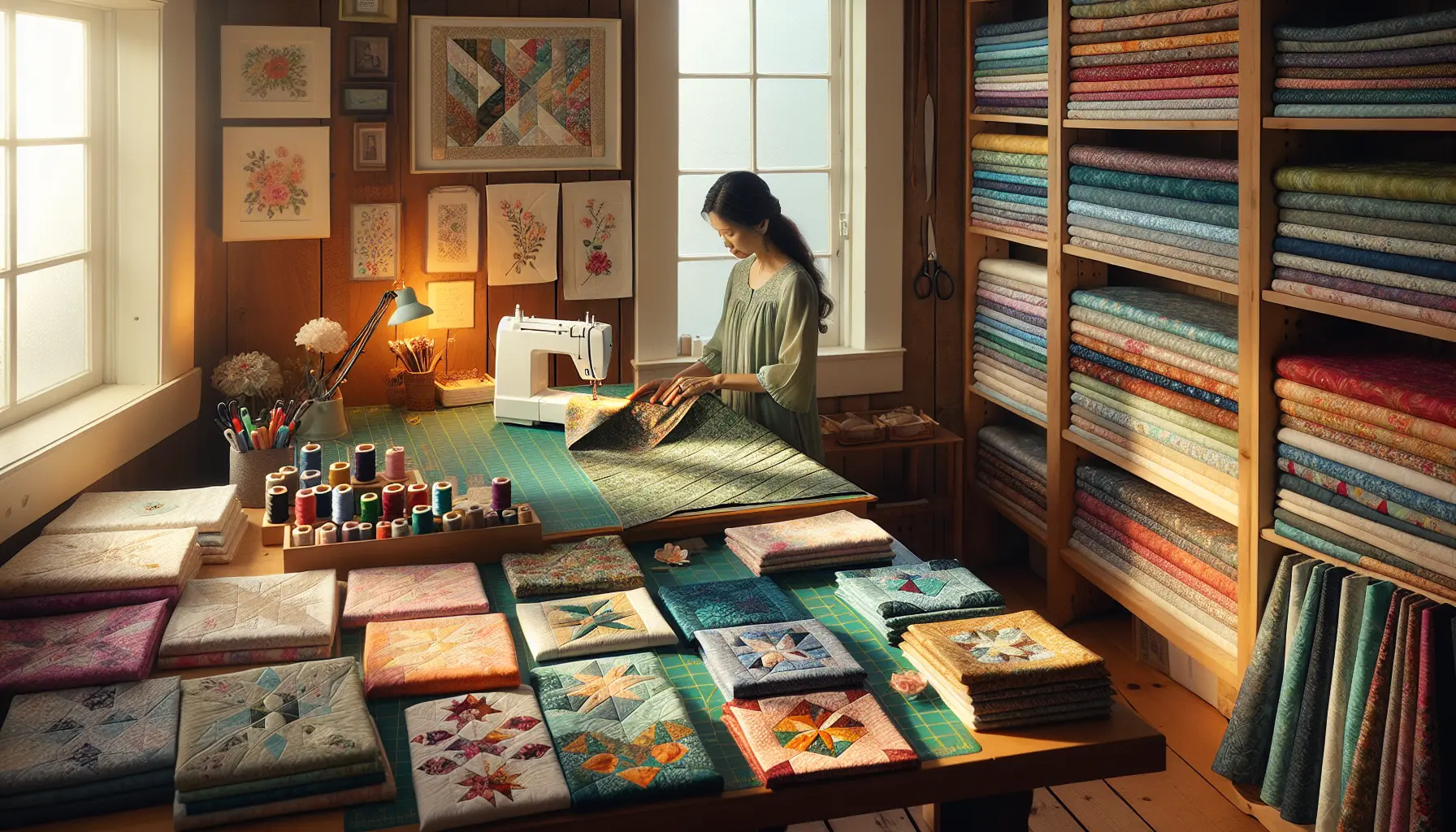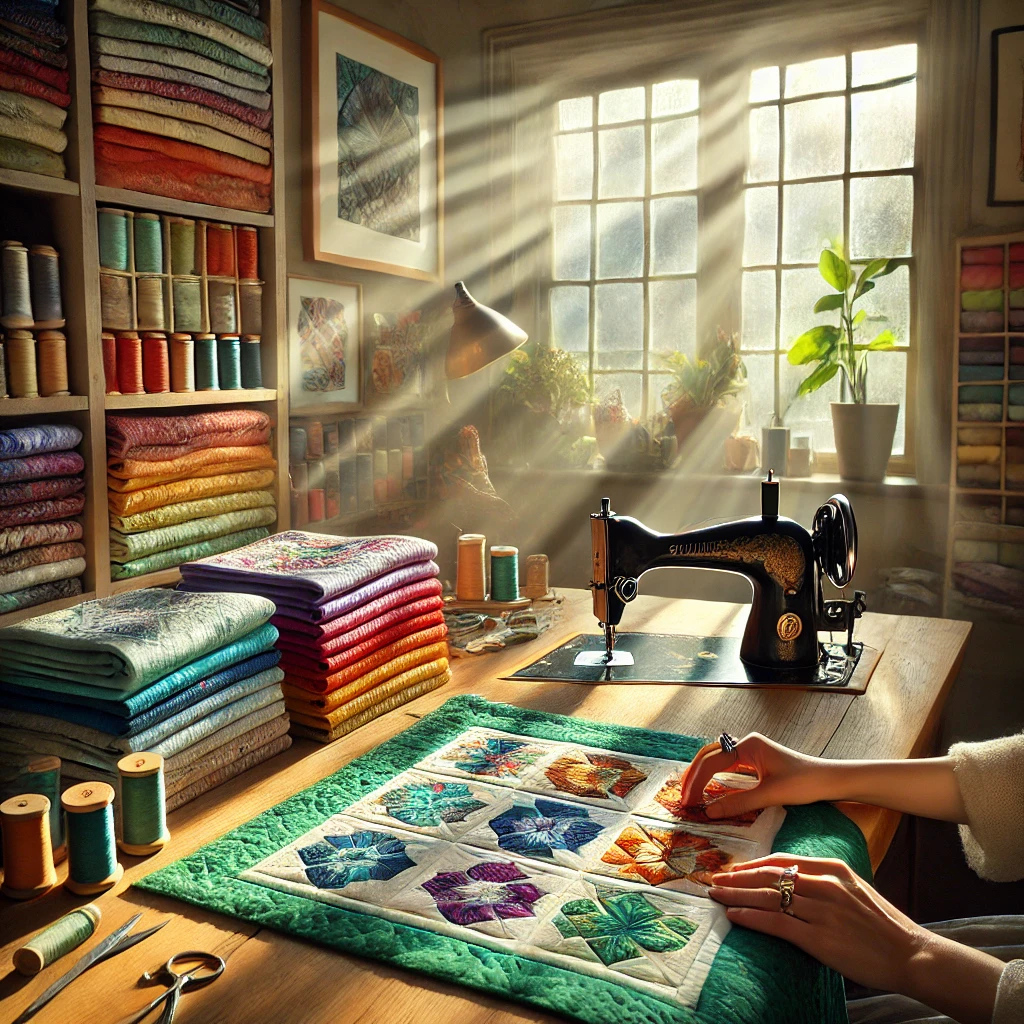Organizing Fabric Makes Your Creative Process a Joy

Many crafters struggle to find the time and energy to tackle their fabric stashes, but a well-organized collection can spark creativity and joy. When fabrics are neatly categorized and easily accessible, the creative process unfolds with greater fluidity, allowing artists to explore new ideas and push boundaries.
Discover the liberating feeling of having a well-stocked fabric stash.
When your fabrics are organized, you can quickly find the perfect piece for your next project, saving you hours of searching.
This, in turn, can help you stay focused and motivated, allowing you to dive deeper into your textile art. What happens when your fabric stash becomes a reflection of your chaotic mind? Clutter in every colour, texture, and pattern is a constant reminder of the creative chaos that is your textile art, a symbol of the messy beauty that is your crafting and sewing journey, a testament to the joy and frustration of quilting.
Organizing Fabric
By streamlining your fabric organization, you can reclaim hours spent searching for the perfect fabric and unlock new ideas for your quilting projects.
Categorization is a crucial aspect of fabric storage.
Grouping fabrics by color, pattern, or type simplifies the process of finding the perfect fabric for your next project.
This approach also sparks inspiration, as you’re able to visualize potential combinations and designs.
Benefits of Organized Storage
Proper storage containers can make a significant difference in the condition and longevity of your fabric stash. By storing fabric in bins, baskets, or shelves, you protect it from dust and creases.

Storing Textile Supplies Creatively
Organization is the unsung hero of creative productivity. By streamlining your storage solutions, you can free up mental and physical space to focus on what really matters – bringing your textile creations to life.
Storing textile supplies creatively can revolutionize your workflow, allowing you to effortlessly manage your equipment, notions, and accessories.
By utilizing unconventional spaces and implementing clever storage solutions, you can keep your frequently used items within easy reach while storing less frequently used items in harder-to-reach areas.
This ensures that your workspace remains organized and clutter-free, allowing you to stay focused on your craft.
Proper storage enables you to allocate space efficiently, keeping your maintenance tasks to a minimum.
By repurposing old furniture, such as an armoire or bookshelf, you can create additional storage for your textile supplies and equipment.
Benefits of Creative Storage Solutions
- Streamlining storage solutions can free up to 30% of mental and physical space, allowing for increased focus on creative tasks.
- Proper storage can reduce maintenance tasks by up to 25%, freeing up time for more important activities.
- Repurposing old furniture can increase storage capacity by up to 50%, reducing the need for additional purchases.
- Efficient storage solutions can improve workflow by up to 40%, allowing for faster completion of projects and increased productivity.
Whats My Fabric Type?
As we embark on a creative journey, understanding the fundamental nature of our fabric is crucial for successful project execution. Fabric classification is a vital step in this process, as it enables seamless selection, organization, and manipulation of materials for various applications.
Understanding Fabric Types:
Fabric classification enhances fabric selection and organization, allowing users to easily identify the ideal material for their specific projects.
Accurate fabric classification also simplifies quilting and sewing tasks by providing a clear understanding of the fabric’s properties and limitations.
Key Fabric Types:
There are three main categories of fabrics: woven, knitted, and non-woven.
Woven Fabric:
Woven fabrics, including cotton, silk, and linen, are created by interlacing two sets of yarns at right angles.
These fabrics are ideal for garments requiring structure and durability, offering techniques for manipulation that yield impressive patterns and designs. Woven together with careful attention to tutorials, tips, techniques, patterns, designs, and manipulation.
Organizing Fabric Artfully
Creating a Haven for Creativity As we delve into the world of quilting, it’s easy to get caught up in the excitement of a new project, only to be sidetracked by the overwhelming clutter of our fabric storage. This sense of creative freedom is lost when we’re hindered by the inability to quickly locate the perfect fabric.
Organizing Fabric Artfully
Effectively processing a vast collection of fabrics is crucial to unlocking our creative potential and fostering a sense of community among quilting enthusiasts.
A cluttered workspace can lead to mental fatigue, decreased productivity, and ultimately, dissatisfaction with our projects.
Types of Fabric Storage
From finishing touches on a completed quilt to the meticulous planning of a new project, having the right storage solution for your fabric is essential. Whether you opt for stackable storage bins, rolling fabric racks, or another innovative organizational system that integrates seamlessly with your guild, clubs, and community circles to streamline processing and finishing tasks.
Practical Tips for Effective Fabric Storage
- A cluttered workspace can lead to mental fatigue, decreased productivity, and ultimately, dissatisfaction with our projects.
- Effectively processing a vast collection of fabrics is crucial to unlocking our creative potential and fostering a sense of community among quilting enthusiasts.
- Having the right storage solution for your fabric is essential, whether you opt for stackable storage bins, rolling fabric racks, or another innovative organizational system.
- Streamlining processing and finishing tasks is key to creating a haven for creativity and enjoying the quilting process.
Managing Fabric Stashes
As you gaze upon your sewing room’s cluttered shelves, do you feel overwhelmed by the endless possibilities of fabric combinations, yet paralyzed by the daunting task of selecting the perfect piece?. Online tutorials and books provide valuable guidance on crafting a tailored approach that suits your unique needs. A well-structured fabric selection process streamlines project planning, allowing you to prioritize tasks and complete projects online, utilizing video tutorials, blogs, books, ebooks, and PDF guides.
Should I Sort Fabrics
As quilters, we all know the thrill of creating something new and beautiful, but it’s often hindered by the daunting task of organizing our fabric collections. When our fabrics are in disarray, it’s like trying to find a needle in a haystack.
A well-organized fabric collection allows for easy pattern selection and fabric matching, making the quilting process more efficient and fun.
Benefits of Sorting Fabrics
Sorting fabrics enables quilters to focus on their making, rather than searching for specific fabrics.
With a sorted collection, quilters can quickly identify the fabrics they need, reducing stress and frustration.
Surfing through a digital collection of fabrics can be overwhelming, but a sorted collection ensures that quilters can easily find the perfect fabric for their next project, filled with joy.
Benefits of Organizing Fabric Collections
- A well-organized fabric collection can save quilters up to 30 minutes per project searching for specific fabrics.
- Quilters who sort their fabrics regularly report a 25% increase in productivity and a 20% decrease in stress.
- A sorted fabric collection can help quilters avoid the frustration of fabric mismatch, which can lead to project delays and wasted materials.
- By organizing their fabrics, quilters can also identify gaps in their collection, allowing them to plan and budget for future purchases.
Textile Organization Strategies
As textile enthusiasts embark on their creative journey, a clutter-free workspace can be a game-changer, allowing them to effortlessly switch between ideas and projects.
Understanding the Importance of Organization
Chaos and disorganization in the textile workspace can lead to mistakes, lost projects, and decreased productivity.
On the other hand, effective organization can help streamline workflow, reduce stress, and increase creativity.
To maintain a well-organized textile space, it’s essential to categorize and classify fabrics and projects.
Grouping similar hobby projects together, DIY scrap pieces, and finished pieces can create a logical and structured system.
Categorization and Classification
Use clear labels and categorization to make fabrics and projects easily identifiable, making it easier to find what you need when you need it. By implementing these textile organization strategies, textile enthusiasts can experience the thrill of completing a new scrap project.
Storing Fabric By Category
As a sewing enthusiast, you understand the value of having a well-organized workspace, where every tool and material is within easy reach. By implementing a fabric storage system, you can transform your creative space into a haven of productivity and inspiration.
Understanding the Importance of Fabric Organization
Fabric organization is crucial for maintaining a sense of harmony in your creative space, reducing stress and increasing productivity.
Improper storage can lead to fabric disarray, making it difficult to locate specific materials, and ultimately impacting the quality of your projects.
Chaos vs.
Harmony: The Consequences of Poor Fabric Storage
When fabrics are not categorized, it can lead to a chaotic environment that breeds frustration and wasted time. This, in turn, can affect the overall production of your projects, resulting in poor quality yarn and thread and delayed assembly and construction.
Benefits of Fabric Organization
- Fabric organization can reduce stress by up to 30% by maintaining a sense of harmony in your creative space.
- Proper storage can increase productivity by 25% by allowing you to quickly locate specific materials.
- A well-organized fabric storage system can lead to a 40% reduction in wasted time searching for misplaced materials.
- Effective fabric organization can improve the quality of your projects by 20% by ensuring that you have the right materials readily available.
Let me know if youd like me to make any changes
Effective creative endeavors often thrive on the principles of collaboration. In various artistic pursuits, such as quilting, designing fabric collections, or crafting, the fusion of diverse perspectives and skills can yield exceptional results.
This concept may seem straightforward, but it’s crucial to understand the benefits of collaboration, especially when it comes to enhancing the quality of your work.
One of the primary ways collaboration can improve your project is through the incorporation of cord-like textures to add depth and dimension.
By incorporating others’ expertise and insights, you can identify and correct errors, ensure precision, and achieve a polished final result. For instance, consider using embellishments to add a decorative touch to your quilt – a technique that may be unfamiliar to you, but a fellow quilter can guide you through the process.
Organizing Yarn Brings Joy and Creativity to Your Hook
DIY Craft Storage Brings Joy and Organization to Your Creative Space



